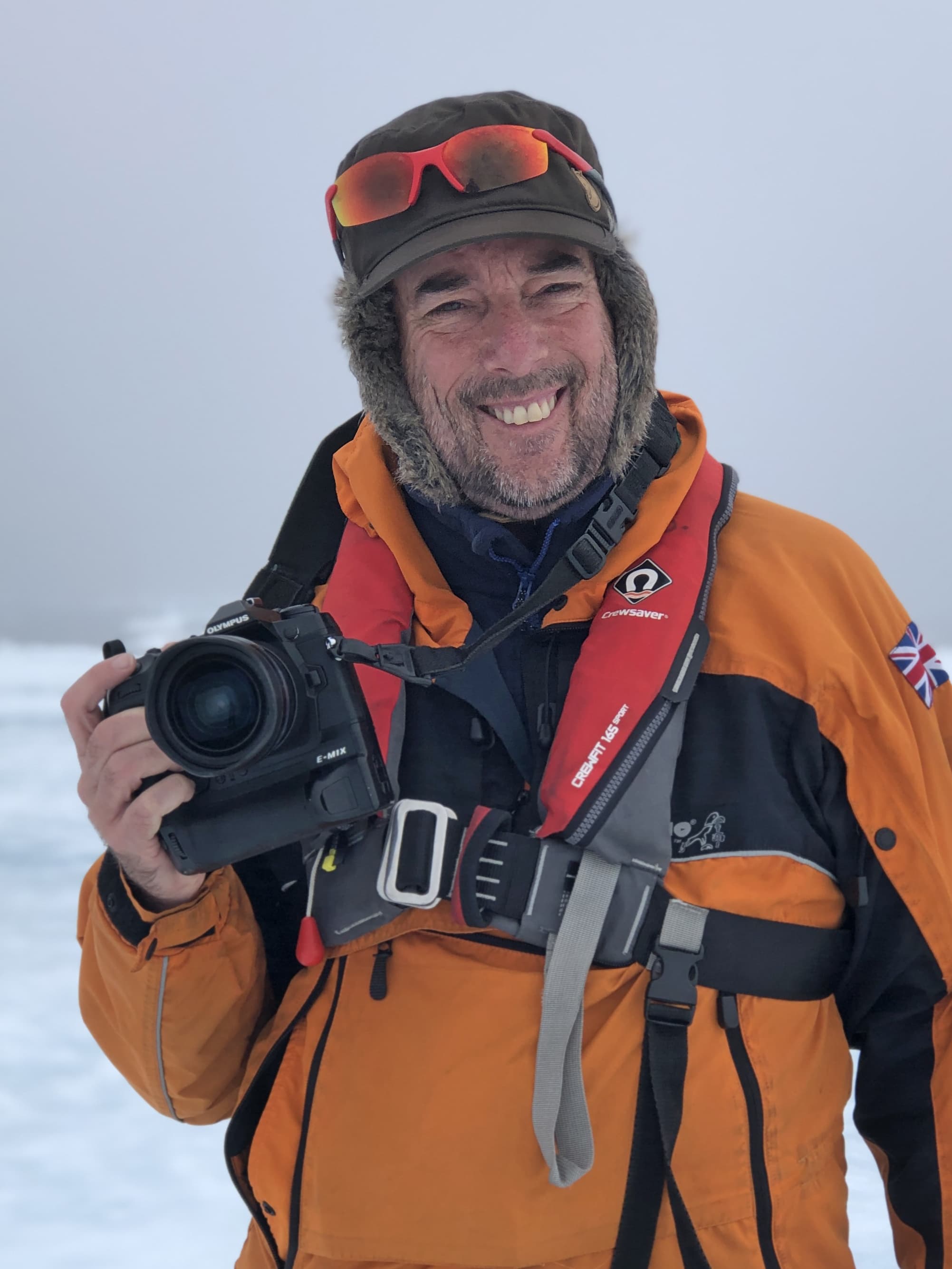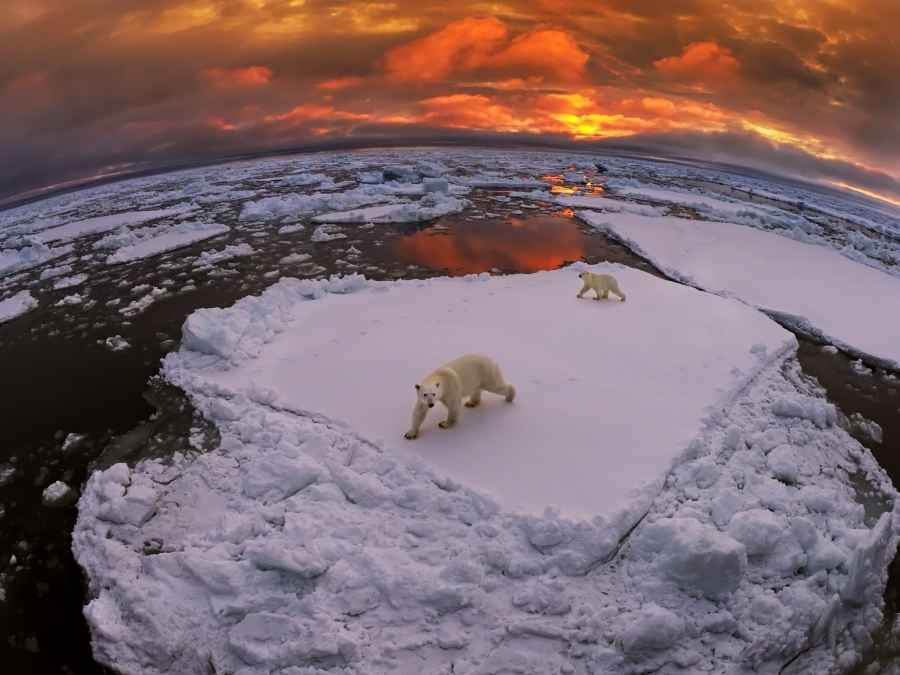Patience, respect for animals and a large slice of luck went into photographer Andy Rouse capturing his astonishing image Sunset at the Top of the World. Andy explains, ‘This was shot in Svalbard in August 2019. I was leading a two-week trip to get amongst the sea ice to see what we could find and what wildlife we could experience. We were completely isolated for nearly two weeks. It’s an awesome feeling and brings me alive as a photographer. I work best when I’m with a small group or by myself. I’m not anti-social but I think you just come to know what makes you tick as a photographer and what you need in order to be in your best mindset.’

Andy was leading a party of 12 on the icebreaker ship the M/S Stockholm and, along with a local guide, had planned out the trip. ‘We made a plan about what we were going to do, where we wanted to be, what we wanted to check out on the way and what kind of experiences we wanted to give our guests for the pick of the wildlife. It’s always good fun and is inspiring. When you’ve got people with you, you want to give them the trip of a lifetime. You don’t just want to serve up the next animal for them to photograph; you want to give them fantastic experiences.’
The image shown here was captured towards the end of a day in which the ship’s engines had been shut off and the vessel had been drifting, with the polar bears in close proximity, swimming by and walking on the sea ice. Andy regards the situation as ‘unique’. He expands, ‘We’re very good at finding and tracking bears but whether they want to come to the ship is up to them. They come because they’re interested – we’re something different and unique. They want the interaction and they’re naturally inquisitive.’
He continues, ‘In this case we spent several hours with this mother, most of the day. We were making hardly any noise at all and being very careful when we walked around the deck. Everyone was watching and really enjoying her playing with her cub out on the ice – it was beautiful to watch. As she got more confident she wanted to bring the cub to have a look. And you know, with experience, that this is actually going to happen.’
Andy explains, ‘You’ve got to spend time on these animals. You must never ever cause them to run, to get scared or anything [like that]. Everything is done with the maximum respect for the bear. Photography isn’t a consideration. It’s about the experience and about giving the bear a positive experience of meeting up. If we get pictures out of it, then we do.’
Lucky break
He openly admits getting the shot was ‘…just luck. The sunsets at that time of year are long, lingering sunsets but the light is challenging. We can’t control where the encounter takes place because we’re on drifting ice – it’s up to the bear where it wants the encounter to take place.‘
The picture was shot with Andy’s 20MP Olympus OM-D E-M1X Micro Four Thirds camera and an Olympus M.Zuiko Digital ED 8mm F1.8 PRO fisheye lens. He reveals, ‘We were standing at the bow of the ship. My clients were all in front of me shooting and I couldn’t see…so I held the camera above my head, which gives you an idea of the lightness. I was holding the camera on tiptoes, using the flip-out screen pointing down at me so I could look at the image, looking at the bears for the fisheye effect and there you go. I wasn’t looking through the viewfinder at all – that’s how I shot the picture. It was beautiful, an amazing scene. They [the polar bears] were only on the ice for a few minutes and were only in the perfect position for seconds.’
Andy reveals, ‘You’ve got to be very careful that you’ve got a reason to use the fisheye [lens] and an environment that screams “Use Fisheye!” I wanted to remove the flatness and drabness of the ice stretching to the sides [of the frame]. If
I gave it more of a curved feel it almost hemmed in the subject, focused on the subject and it gave this “feel” like they were walking across the top of the Earth, which is what I wanted to do.’
He concludes, ‘The ice break-up that you see there isn’t climate change; it’s natural ice break-up. But, of course, climate change is in everyone’s minds and I hope an image like this will make people look and think twice. Climate change is real and affects real people and real animals. I hope maybe the picture is used to change some opinions and inspire some others to love the Arctic like I do.’

Andy’s kit
Since May 2019 Andy has been shooting exclusively with the Olympus mirrorless camera system. He currently works with the E-M1 Mark III and E-M1X cameras and has a variety of the Olympus Pro lenses in his kitbag. Andy reveals, ‘I was an early tester of the 100-400mm [lens], which I had six weeks before any one else. I was a very early tester for the OM-D E-M1 Mark III, so I’ve got that. I’ve got macros, I’ve got the 40-150mm [lens]… the ‘go-to’ lens right now is the 100-400mm.’

About Andy Rouse
Andy Rouse is a wildlife photographer, filmmaker and conservationist who has won many awards in competitions such as the Wildlife Photographer of the Year and Nature’s Best. His work sells worldwide – from traditional publishing, such as calendars and cards, to haute couture fashion and even the tailplanes of aircraft. He has authored many books, including the critically acclaimed Concepts of Nature and Gorillas, and has appeared on numerous TV programmes. See his website here.
Further reading
Federico Borella’s Climate Change project
Our best-ever tips for wildlife photography








